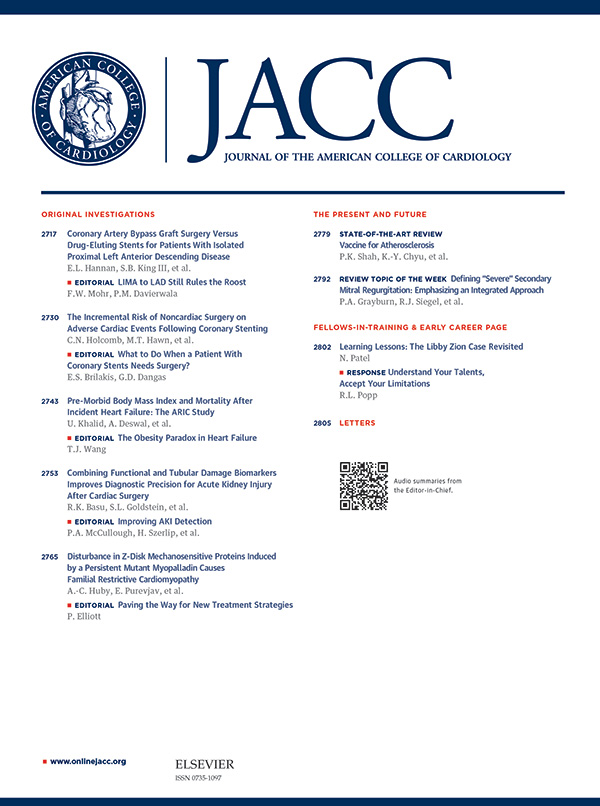Loeys-Dietz综合征动脉动脉瘤的特征分析
IF 22.3
1区 医学
Q1 CARDIAC & CARDIOVASCULAR SYSTEMS
引用次数: 0
摘要
背景:与其他遗传性胸主动脉疾病(HTADs)相比,Loeys-Dietz综合征(LDS)中主动脉外动脉瘤(AAs)的存在是值得注意的。然而,到目前为止,LDS中原子吸收剂的特征还没有得到很好的描述。目的:我们试图确定LDS中AAs的患病率、特征和临床结果。方法对1998年至2023年在华盛顿大学圣路易斯医学院/巴恩斯犹太医院评估的LDS患者进行回顾性队列研究。汇总与AAs相关的临床资料、影像学资料和预后。结果共纳入来自60个家族的103例LDS 1 ~ 5患者(53%为女性),由TGFBR1、TGFBR2、SMAD3、TGFB2和TGFB3的致病或可能致病变异引起。中位年龄44岁,中位随访6年。43例患者共鉴定出77例AAs: 9例TGFBR1变异体患者17例AAs, 15例TGFBR2变异体患者33例AAs, 8例SMAD3变异体患者15例AAs, 8例TGFB2变异体患者9例AAs, 3例TGFB3变异体患者3例AAs。AA诊断的中位年龄为40岁;75%的AAs位于弓血管或脑循环。在单因素分析中,基线时的主动脉事件(A/B型夹层或预防性主动脉手术)和基线时的预防性主动脉手术与AA的存在相关。远视、小舌二裂和动脉扭曲接近统计学意义。预测AA的多变量模型包括基线预防性主动脉手术和动脉扭曲。在初始影像学无AA的vs患者中,分别有61%和35%的患者出现过主动脉事件。17%的AAs随着时间的推移而扩大,38%的AAs扩大导致临床事件(预防性手术、剥离或破裂)。总体而言,22%的aa相关事件发生在整个动脉树中。通过开放手术和血管内技术修复AAs。结论sas常见于LDS患者,可发生于整个动脉树。重要的是,AAs可能导致包括动脉剥离和破裂在内的临床事件。在诊断和随访期间,LDS推荐头部骨盆成像来评估AAs及其并发症。本文章由计算机程序翻译,如有差异,请以英文原文为准。

Characterization of Arterial Aneurysms in Loeys-Dietz Syndrome
Background
The presence of extra-aortic arterial aneurysms (AAs) is notable in Loeys-Dietz syndrome (LDS) compared with other heritable thoracic aortic diseases (HTADs). However, the characteristics of AAs in LDS are poorly characterized to date.
Objectives
We sought to determine the prevalence, characteristics, and clinical outcomes of AAs in LDS.
Methods
A retrospective cohort study of LDS patients evaluated at Washington University in St Louis School of Medicine/Barnes-Jewish Hospital between 1998 and 2023 was performed. Clinical information, imaging data, and outcomes related to AAs were compiled.
Results
A total of 103 patients (53% female) from 60 families with LDS 1 through 5 caused by pathogenic/likely pathogenic variants in TGFBR1, TGFBR2, SMAD3, TGFB2, and TGFB3 were included. The median age was 44 years, and median follow-up was 6 years. In total, 77 AAs were identified in 43 patients: 17 AAs in 9 patients with TGFBR1 variants, 33 AAs in 15 patients with TGFBR2, 15 AAs in 8 patients with SMAD3, 9 AAs in 8 patients with TGFB2, and 3 AAs in 3 patients with TGFB3. The median age at AA diagnosis was 40 years; 75% of AAs were in the arch vessels or cerebral circulation. On univariate analysis, aortic event (type A/B dissection or prophylactic aortic surgery) at baseline and prophylactic aortic surgery at baseline were associated with the presence of an AA. Hypertelorism, bifid uvula, and arterial tortuosity approached statistical significance. A multivariate model to predict AA included baseline prophylactic aortic surgery and arterial tortuosity. Of those with vs without AA on initial imaging, 61% and 35%, respectively, presented with previous aortic events. Seventeen percent of AAs enlarged over time, and 38% of AAs that enlarged led to clinical events (prophylactic surgery, dissection, or rupture). Overall, AA-related events occurred in 22% of AAs and throughout the arterial tree. AAs were repaired by open surgical and endovascular techniques.
Conclusions
AAs commonly occur in patients with LDS and may occur throughout the arterial tree. Importantly, AAs may lead to clinical events including arterial dissection and rupture. Head to pelvis imaging at diagnosis and during follow-up is recommended in LDS to evaluate for AAs and their complications.
求助全文
通过发布文献求助,成功后即可免费获取论文全文。
去求助
来源期刊
CiteScore
42.70
自引率
3.30%
发文量
5097
审稿时长
2-4 weeks
期刊介绍:
The Journal of the American College of Cardiology (JACC) publishes peer-reviewed articles highlighting all aspects of cardiovascular disease, including original clinical studies, experimental investigations with clear clinical relevance, state-of-the-art papers and viewpoints.
Content Profile:
-Original Investigations
-JACC State-of-the-Art Reviews
-JACC Review Topics of the Week
-Guidelines & Clinical Documents
-JACC Guideline Comparisons
-JACC Scientific Expert Panels
-Cardiovascular Medicine & Society
-Editorial Comments (accompanying every Original Investigation)
-Research Letters
-Fellows-in-Training/Early Career Professional Pages
-Editor’s Pages from the Editor-in-Chief or other invited thought leaders

 求助内容:
求助内容: 应助结果提醒方式:
应助结果提醒方式:


